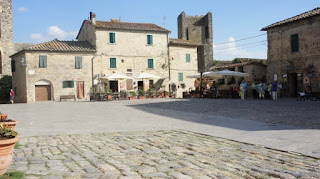Che Bella Giornata! What a beautiful day we had today!
In January, guided by the suggestion of our friends, Ugo and Tiziana, we visited San Gimignano, in Tuscany. The best way to describe it is to say that it is magical, mystical and medieval, all the ingredients for making wonderful moments. So of course, it was on our list of “must do’s” this time as well.
It didn’t disappoint and it was interesting to see it in summer, as opposed to winter. The city is walled and like most medieval cities, built on top of a mountain. Our first sight of the city in January is unforgettable. The day had started off with mist and fog but when we were in sight of S. Gimignano, the sun came out and lit up the walls and the city seemed to shimmer and expand in the crispness of the winter morning. A collective gasp echoed round the car and we couldn’t take our eyes off it. It was as if we had been transported back in time and this city was a metaphor for all the stories of knights and castles and derring-do we had read and relived over the years.
The town was founded in the 3rd C by the Etruscans. It was a strong city and thus, in 1199, it was able to declare its independence from the bishops of Volterra. It continued to flourish until 1348 when the Black Death that affected all of Europe compelled it to submit to Florence.
 |
| Shields from the 1400's in Volterra. These were on a wall in the Piazza and were from the old Volterra families of the 15th C. |
The streets and piazzas in S. Gimignano continue the medieval theme, of course, though now they are filled with cafes, bars, and shopsexhibiting magnificent ceramics, leather goods and alabaster, as Tuscany is the home of alabaster. I had been wanting to buy some ceramic plates and dishes here after seeing all the beautiful things in January, when I did get some smaller pieces, so after checking out the many shops and their diverse offerings, I made my choice- actually, from the first shop we had been into!
 |
| Piazza del Duomo S. Gimignano |
I am very happy, when it suits, to assist the economy of any country I am visiting, so after spending the GDP of Italy on some wonderful serving platters, I felt as if I had done my bit for our second home. The goods, I am informed, will be with us in a few weeks, so we will wait till the multi-million dollars worth of glasses and the carafe arrive from Murano and then we’ll have a party so we can enjoy using them altogether.
While I was waiting for Bill to buy a gelato from a store in the Piazza, I found a book on Tuscany and read up on some of the little villages around S. Gimignano. I didn’t want to buy the book, which was on display outside a newsagency, (edicola) so I sat on the steps of the next door shop and copied out a few names. When Bill returned, munching his gelati, which had been made by some guy who headed the winning team for the national gelati competition last year (true information here) he looked at the map and said we would have time to see a couple of the other villages, so off we went.

No comments:
Post a Comment